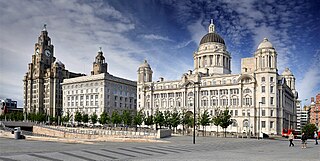
Merseyside is a ceremonial and metropolitan county in North West England. It borders Lancashire to the north, Greater Manchester to the east, Cheshire to the south, the Welsh county of Flintshire across the Dee Estuary to the southwest, and the Irish Sea to the west. All boroughs of the Merseyside area are also part of the Liverpool City Region. The largest settlement is the City of Liverpool.
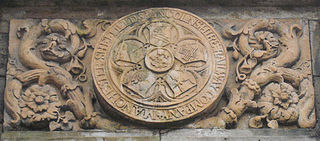
The Manchester, Sheffield and Lincolnshire Railway (MS&LR) was formed in 1847 when the Sheffield, Ashton-under-Lyne and Manchester Railway joined with authorised but unbuilt railway companies, forming a proposed network from Manchester to Grimsby. It pursued a policy of expanding its area of influence, especially in reaching west to Liverpool, which it ultimately did through the medium of the Cheshire Lines Committee network in joint partnership with the Great Northern Railway (GNR) and the Midland Railway.

The Cheshire Lines Committee (CLC) was formed in the 1860s and became the second-largest joint railway in Great Britain. The committee, which was often styled the Cheshire Lines Railway, operated 143 miles (230 km) of track in the then counties of Lancashire and Cheshire. The railway did not become part of the Big Four during the implementation of the 1923 grouping, surviving independently with its own management until the railways were nationalised at the beginning of 1948. The railway served Liverpool, Manchester, Stockport, Warrington, Widnes, Northwich, Winsford, Knutsford, Chester and Southport with connections to many other railways.
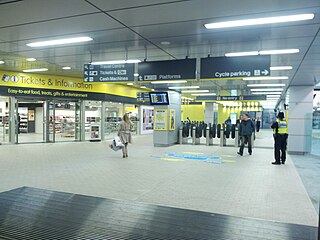
Liverpool Central railway station in Liverpool, England, forms a central hub of the Merseyrail network, being on both the Northern Line and the Wirral Line. The station is located underground on two levels, below the site of a former mainline terminus. It is the busiest station in Liverpool, though considerably smaller than Lime Street station, the mainline terminus, and the busiest station to operate solely on the Merseyrail network. The station is the busiest underground station outside London serving 40,000 people daily. The station in passengers per platform is the busiest underground railway station in the United Kingdom outside of London at 3,979,547 per platform per annum and coming tenth out of all stations outside the capital, underground or overground.

The St Helens and Runcorn Gap Railway was an early railway line owned by a company of the same name in Lancashire, England, which opened in 1833. It was later known as St Helens Railway. It ran originally from the town of St Helens to the area which would later develop into the town of Widnes. Branches were opened to Garston, Warrington and Rainford. The company was taken over by the London and North Western Railway in 1864. The line from St Helens to Widnes and the branch to Rainford are now closed, the latter terminating at the Pilkington Glass' Cowley Hill works siding near Gerard's Bridge, but part of the lines to Garston and to Warrington are still in operation.
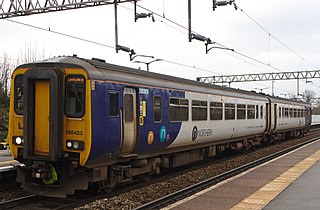
There once were four direct railway routes between Liverpool and Manchester in the North West of England; only two remain, the two centre routes of the four. The most northerly and the most southerly of the four routes are no longer direct lines. Of the remaining two direct routes, the northern route of the two is fully electric, while the now southern route is a diesel-only line. The most northerly of the four has been split into two routes: the western section operated by Merseyrail electric trains and the eastern section by diesel trains, requiring passengers to change trains between the two cities. The fourth route, the most southerly of the four, has been largely abandoned east of Warrington; the remaining section caters mainly for freight trains.

Garston railway station was a railway station in the Garston district of Liverpool, England. The station was located on the Northern Line of the Merseyrail suburban rail network. The station was closed in 2006 when it was replaced by Liverpool South Parkway, which is a combined bus and rail interchange. The proximity of the stations was so close the platforms of South Parkway nearly merged onto the Garston station's platforms.

Liverpool South Parkway station is a railway station and bus interchange in the Garston district of Liverpool, England. It serves, via a bus link, Liverpool John Lennon Airport in the neighbouring suburb of Speke, as well as providing an interchange between main line services and the Merseyrail rapid transit/commuter rail network. Opened in 2006 on the site of the former Allerton railway station, it also replaced the nearby Garston station.

The Northern line is one of two commuter rail routes operated by Merseyrail and centred on Merseyside, England, the other being the Wirral line. The cross-city route runs from Hunts Cross in south Liverpool then branches in the north to terminate at Southport, Headbolt Lane and Ormskirk (Lancashire).

The Wirral line is one of two commuter rail routes operated by Merseyrail and centred on Merseyside, England, the other being the Northern line.
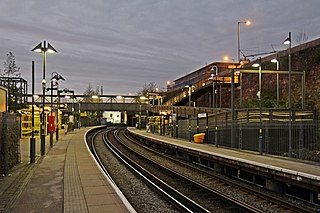
Brunswick railway station serves the Toxteth district of Liverpool, England, on the Northern Line of the Merseyrail network. The station serves the nearby district of Dingle and is situated on a short section of track between two tunnels, between the now in-filled Toxteth and Harrington Docks. The station also serves businesses on the Brunswick Dock estate, which gives it name to the station. The residential area of Grafton Street is reached by steps or ramp from the southbound platform.
The North Liverpool Extension Line was a railway line in Liverpool, England in operation between 1879 and 1972. It was at one stage intended to become the eastern section of the Merseyrail Outer Loop, an orbital line circling the city.

Aigburth railway station serves the Aigburth district of Liverpool, England. It is situated on the Southport–Hunts Cross route of the Northern Line of the Merseyrail suburban system.

The City Line is the brand name used by Merseytravel on suburban rail services in the Liverpool City Region starting eastwards from the mainline platforms of Liverpool Lime Street railway station.

Liverpool Central High Level was a terminus railway station in central Liverpool, England. It opened on 1 March 1874, at the western end of the Cheshire Lines Committee (CLC) line to Manchester Central. It replaced Brunswick as the CLC's Liverpool passenger terminus, becoming the headquarters of the committee.

The Warrington and Altrincham Junction Railway was a railway line that was in operation from 1 November 1853 to 7 July 1985. The railway was created by an act of Parliament, the Warrington and Altrincham Junction Railway Act 1851, on 3 July 1851 to build a line between Timperley Junction on the Manchester, South Junction and Altrincham Railway (MSJAR), to provide a through route to Manchester, and Warrington Arpley on the St Helens and Runcorn Gap Railway providing a link with Liverpool.
Liverpool in North West England, is a major British city with significant road, rail, and ferry networks, in addition to an international airport and a well-known dock system. As with most other major UK cities, Liverpool's transport infrastructure is centred on its road and rail networks. Public transport services within the city are controlled and run by Merseytravel.
Garston Dock railway station served Garston, Liverpool, Merseyside, England and Garston Docks. It was situated on the east side of Dock Road.

Cressington railway station serves the Grassendale district of Liverpool, England. It is situated on the Southport-Hunts Cross route of the Northern Line of the Merseyrail suburban system. The station takes its name from the Cressington Park area inside of Cressington.
The history of Merseyrail dates back to the 19th century, with the original formation of the Mersey Railway, however, Merseyrail dates back to the 20th century, namely being set up by British Rail in 1969, it did not become a single network until 1977.




















